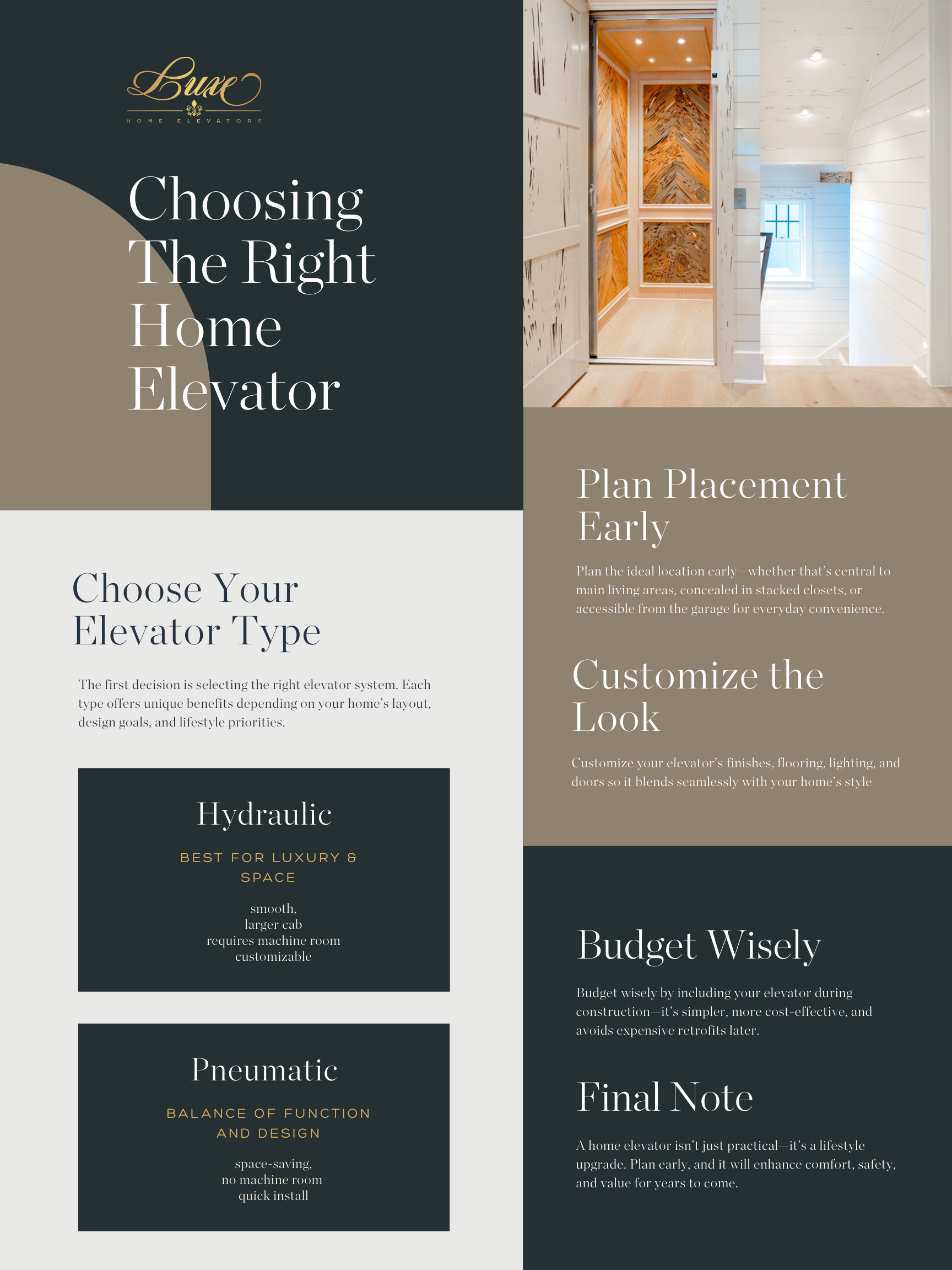How to Choose the Right Home Elevator
Planning a Custom Home? Here's How to Choose the Right Home Elevator
Designing your dream home comes with countless exciting decisions. If you’re thinking ahead about accessibility, comfort, and future needs, a residential elevator should be part of the plan.
Installing a home elevator during the construction of a new custom home is often easier and more cost-effective than retrofitting one later. But how do you choose the right elevator for your space, lifestyle, and goals?
In this article, we’ll walk you through key factors to consider when selecting the perfect elevator for your new custom home.
Why Include a Residential Elevator in Your Custom Home Plan?
Whether you’re building a multi-level luxury residence or a forever home designed to age with you, a residential elevator adds both function and long-term value.
Here’s why many homeowners include them from the start:
Future-Proofing: Plan for mobility needs now—before you need them.
Convenience: Make daily tasks like carrying laundry, groceries, or suitcases between floors much easier.
Property Value: Elevators are seen as premium features by homebuyers and can increase resale potential.
Design Flexibility: Building new allows you to fully integrate the elevator into your home’s layout and aesthetics.
Step 1: Consider Your Elevator Type
The two most common systems used in homes are hydraulic home elevators and pneumatic home elevators. Each offers unique benefits depending on your goals, floor plan, and design vision.
Hydraulic Home Elevators
Best for: Smooth, quiet operation and larger homes with ample space.
Uses a fluid-powered piston system
Requires a machine room (usually in a basement or adjacent space)
Supports higher weight capacity and larger cab sizes
Fully customizable with luxury materials and finishes
Pro Tip: If you want a more traditional or luxury feel with a spacious cab, hydraulic is often the best choice.
Pneumatic Home Elevators
Best for: Modern design and homes where space is limited.
Uses air pressure in a vertical tube to move the cab
No machine room required
Quick to install and energy-efficient
Sleek, minimal design with a panoramic look
Pro Tip: Pneumatic elevators are ideal for tight spaces or contemporary homes with a clean design aesthetic.
Step 2: Think About Placement Early
When you're in the design phase of your custom home, you have the advantage of choosing the best possible location for your elevator. Consider:
Central Access: Near the kitchen, garage, or main living areas for maximum convenience
Stacked Closets: Use vertically aligned closets to conceal the elevator shaft
Garage or Entry Access: Ideal for bringing in groceries, luggage, or avoiding stairs
Early planning gives you more freedom to seamlessly integrate your custom home elevator into your floor plan without compromising space or aesthetics.
Step 3: Customize the Look and Feel
Your elevator should match the overall style of your home. When building new, you have the flexibility to customize:
Cab finishes (wood, glass, metal, etc.)
Flooring to match your interiors
Control panels and interior lighting
Door style (swing, sliding, or glass)
Whether your style is rustic, modern, or classic, your elevator can complement it beautifully.
Step 4: Budget with the Future in Mind
Including a residential elevator in your custom home budget is easier than trying to add one later. During construction, installation is simpler, more cost-effective, and won’t require altering finished spaces.
It’s also an investment in long-term convenience. If you plan to stay in your home for years—or even decades—it’s a smart way to make your home more livable at every stage of life.
Final Thoughts
A home elevator isn’t just a feature—it’s a lifestyle upgrade. When thoughtfully planned and professionally installed, it adds ease, elegance, and future flexibility to your home.
If you’re designing a new custom home, don’t wait until it’s built to think about mobility and convenience. By planning your elevator early, you’ll ensure it fits seamlessly into your layout and adds value for years to come.
Need help designing the right elevator for your new home?
Contact our team today for a consultation. We’ll help you explore the best options, placement, and styles to suit your vision.

